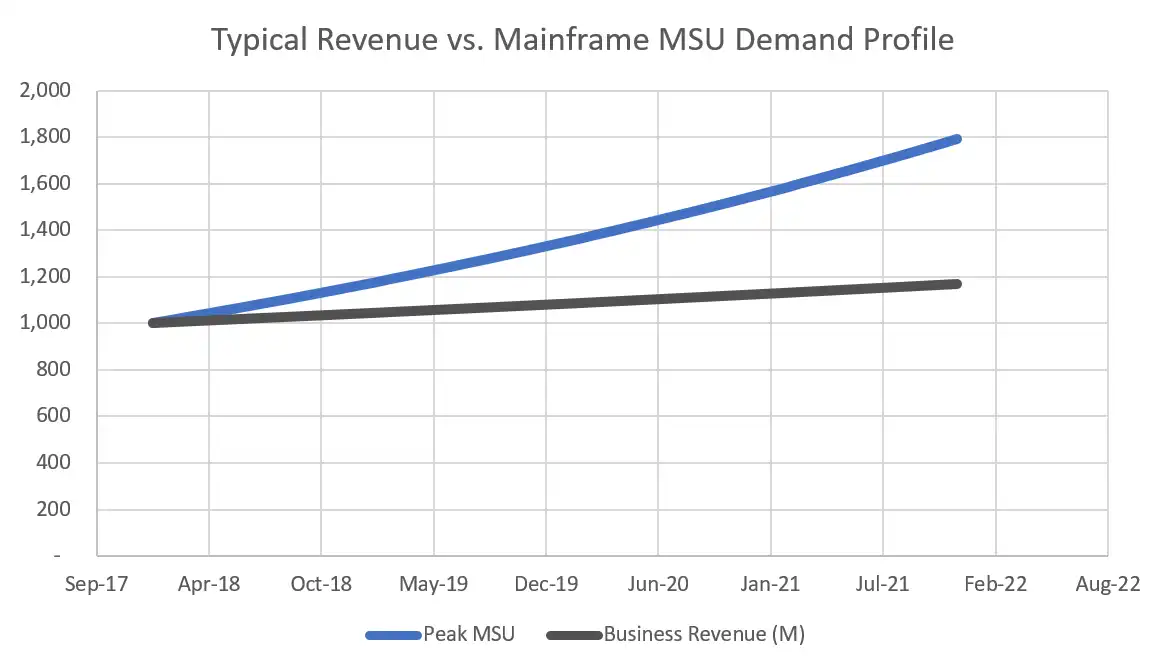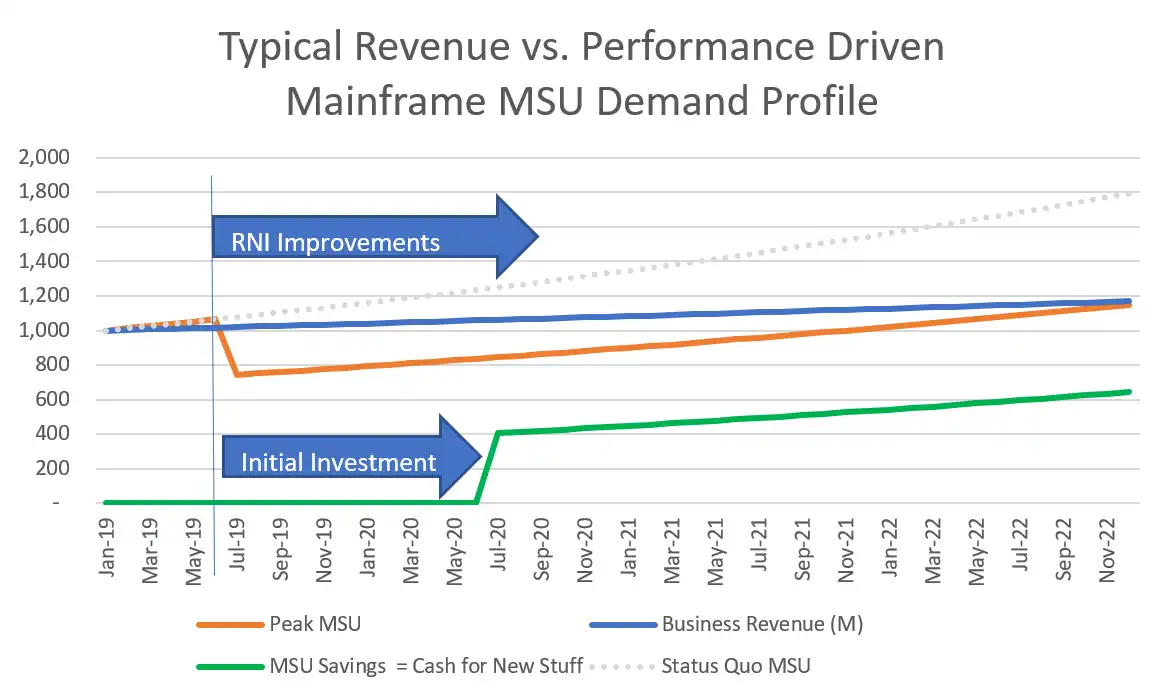How does your MSU growth compare to your revenue growth? As the new year begins, how are your goals aligning with the business?
While this is purely a hypothetical example that plots typical compute growth rates (~15%) with business revenue growth (~4%), there are many of you that would agree with the widening gap. Whether it is MSU’s or midrange server costs vs. revenue, this graphic is commonplace.
The simplification above ignores seasonality and other variables that may also impact growth, but it demonstrates the problem nearly every CIO has. How can the gap for IT spending vs. revenue and/or profit be managed so that additional spending on other key components of the business can deploy the cash needed to build revenue and profit?
Marginal Capacity Plans
While the overall unit cost of computing continues to drop due to the fantastic advances in the technology over the years, few involved in performance and capacity can claim a long term drop in peak demand ‘resource costs’ over time due to changes your organization has made. In fact, most would share something similar to the above graphic over the last few years. Is your latest projection going to look different?
The actual values observed in 2-5 years for resource demand-and IT costs, as compared to prior forecasts, are often off by large margins. These deviations led a colleague to make the following statement in reference to a new capacity plan: “the only thing I can be certain of with this plan is that it will be wrong”. While there are many possible reasons that are outside your control, it is a cold reality.
And it might ‘hurt’ our pride a bit, but there is some truth there.
Some advice to capacity planners
- Don’t take it personal.
- Planning is useful primarily as a budgeting tool – treat it as such. Don’t expect a beautiful mathematical modeling exercise that predicts the march madness bracket winners correctly – because it won’t!
- The primary drivers influencing changes are typically outside your control – Don’t ignore them; list them, try to obtain some valuable insights from your business and application partners. Focus on the top two or three, (80/20 rule) and lump the rest in an ‘organic growth’ It’s a long tail and quantifying all of it will cost you more in time and money than you can save by budgeting better for 25 different micro services that are less than 1% of the budget each.
- Tell the story with good graphics and succinct insights.
- Identify useful alternatives to just buying more CPUs, memory, disks and network bandwidth.
- Good performance is primary.
What is Good Performance?
Sometimes we in the mainframe arena take “good” performance for granted. We have WLM, capacity on Demand, zIIPs, PAVs, and on down the list.
“Good performance” is meeting all of those response time goals while being efficient. Two people can drive from Denver to San Francisco with similar comfort in an SUV at 8 MPG with some bad spark plugs or in a 48 MPG hybrid vehicle.
Planning your trip does involve the workload and capacity of your current vehicle, but given your situation, our focus is on efficiency. We want to help you stretch that 8 miles per gallon (MPG) to 25 MPG for the SUV. What should the focus be on in the mainframe performance before we produce the plan?
Some efficiency focused metrics worth pursuing include things like:
- latency (response time)
- CPU time per transaction
- Cache Hit %
- Relative Nest Intensity (RNI)
- and so on.
One very visible example from our own Todd Havekost demonstrates the value of lowering your RNI (Relative Nest Intensity) using some configuration changes.
Just a quick refresh on RNI: a lower value indicates improved processor efficiency for a constant workload. A lower RNI drives lower MSU for the same workload, and the results can be significant!
There are several ways to drive for lower RNI, and the reference above gives you several ideas on where to start. Look at how a small change in a performance metric can alter the long-term capacity plan!
Performance Led Capacity Plan
While you don’t often receive a gift like this in your performance options, keep informed.
Part of your capacity planning regimen should be working with your colleagues in systems, DB2, CICS, and applications to solicit changes that might deliver a welcome demand drop and slower future growth. A small change in the rudder, can move a mighty ship!
System Efficiency and Your Capacity Planning Process
Capacity planning is an important input to the budget process. Efficiency recommendations will help you keep your organization lean and productive. Look for some opportunities to improve efficiency as you produce the artifacts necessary for the budget process.
In this first blog, I have provided you one efficiency check to consider. Are there better ways to configure and manage your systems to reduce your RNI? In my next blog, I will open the door for some other ideas to evaluate efficiency as you prepare your capacity plan for the future mainframe growth. Feel free to reach out to us for more insights as we develop part two of this post.
This article's author
Share this blog
You May Also Be Interested In
What's New with IntelliMagic Vision for z/OS? 2024.2
February 26, 2024 | This month we've introduced changes to the presentation of Db2, CICS, and MQ variables from rates to counts, updates to Key Processor Configuration, and the inclusion of new report sets for CICS Transaction Event Counts.
Top ‘IntelliMagic zAcademy’ Webinars of 2023
View the top rated mainframe performance webinars of 2023 covering insights on the z16, overcoming skills gap challenges, understanding z/OS configuration, and more!
Why Am I Still Seeing zIIP Eligible Work?
zIIP-eligible CPU consumption that overflows onto general purpose CPs (GCPs) – known as “zIIP crossover” - is a key focal point for software cost savings. However, despite your meticulous efforts, it is possible that zIIP crossover work is still consuming GCP cycles unnecessarily.
Book a Demo or Connect With an Expert
Discuss your technical or sales-related questions with our mainframe experts today



 Jack Opgenorth
Jack Opgenorth